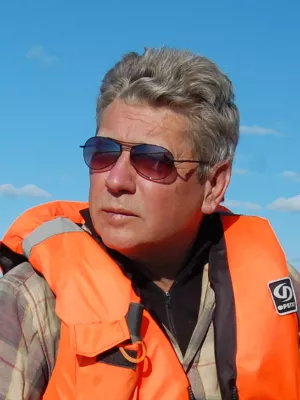
Per Möller
Professor

Instantaneous end moraine and sediment wedge formation during the 1890 glacier surge of Brúarjökull, Iceland
Author
Summary, in English
Contemporary understanding of the behaviour of surging glaciers and ice streams is hampered by the lack of data on landsystem evolution and sedimentary environments. This study concerns the ice-marginal environment of the surge-type Brúarjökull in Iceland. The sediment distribution in the glacier forefield as well as the morphology, sedimentology and tectonic architecture of the 1890 end moraine is investigated for highlighting the interaction between very dynamic ice and sediment/landform associations.
As a result of substrate/bedrock decoupling during the 1890 surge, subglacial sediment was dislocated across the bedrock surface and deformed compressively, leading to gradual substrate thickening and the formation of a sediment wedge in the marginal zone. A drop in subglacial porewater pressure at the very end of the surge led to substrate/bedrock coupling and a stress transfer up into the sediment sequence causing brittle deformation of the substrate. Simultaneously, the glacier toe ploughed into the topmost part of the marginal sediment wedge initiating the moraine-ridge construction. Fine-grained and incompetent sediment deformed in ductile manner, resulting in a narrow moraine dominated by rooted folds, while coarse-grained and competent sediment deformed in brittle fashion, resulting in a wider moraine dominated by thrust blocks.
A new sequential model of subglacial and ice-marginal processes operating during a glacier surge is proposed, illustrating the stepwise formation of a marginal sediment wedge and an end moraine—a twofold, inseparable marginal end-product that formed during the last days of the 1890 surge.
As a result of substrate/bedrock decoupling during the 1890 surge, subglacial sediment was dislocated across the bedrock surface and deformed compressively, leading to gradual substrate thickening and the formation of a sediment wedge in the marginal zone. A drop in subglacial porewater pressure at the very end of the surge led to substrate/bedrock coupling and a stress transfer up into the sediment sequence causing brittle deformation of the substrate. Simultaneously, the glacier toe ploughed into the topmost part of the marginal sediment wedge initiating the moraine-ridge construction. Fine-grained and incompetent sediment deformed in ductile manner, resulting in a narrow moraine dominated by rooted folds, while coarse-grained and competent sediment deformed in brittle fashion, resulting in a wider moraine dominated by thrust blocks.
A new sequential model of subglacial and ice-marginal processes operating during a glacier surge is proposed, illustrating the stepwise formation of a marginal sediment wedge and an end moraine—a twofold, inseparable marginal end-product that formed during the last days of the 1890 surge.
Department/s
- Quaternary Sciences
Publishing year
2008
Language
English
Pages
209-234
Publication/Series
Quaternary Science Reviews
Volume
27
Issue
3-4
Links
Document type
Journal article
Publisher
Elsevier
Topic
- Geology
Status
Published
ISBN/ISSN/Other
- ISSN: 0277-3791

